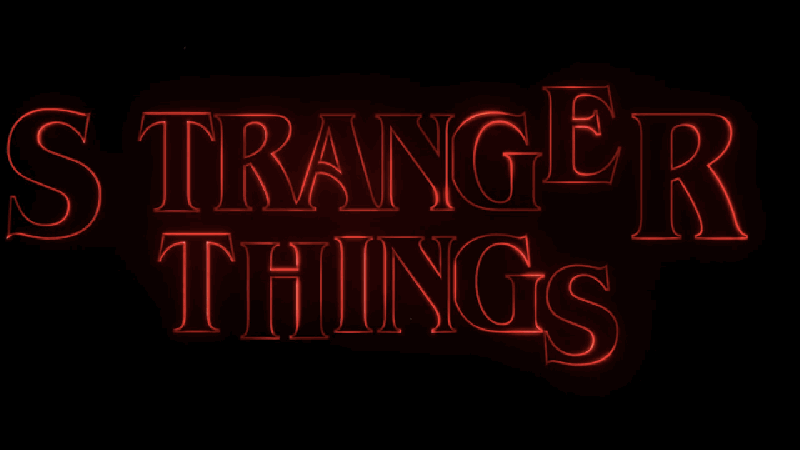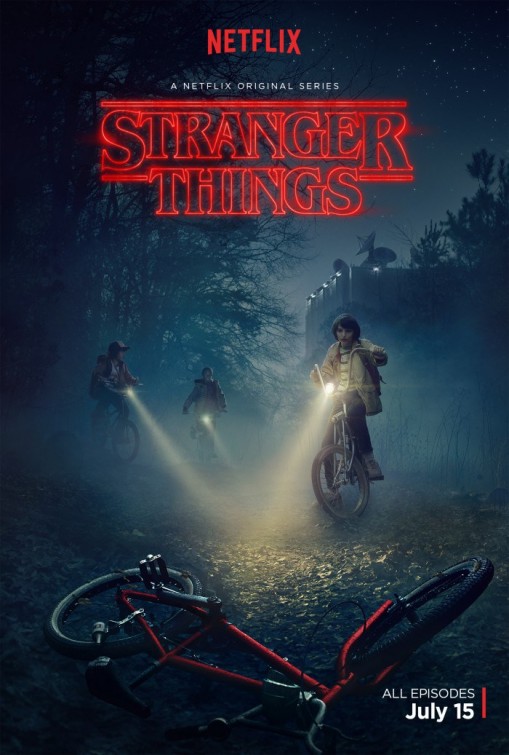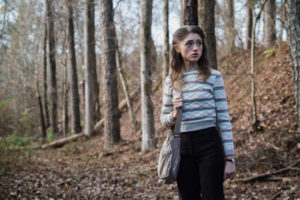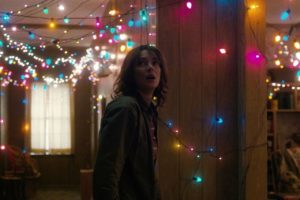As with the release of any of Netflix’s “bing it all at once” television seasons, this weekend my social feed went from a stray mention of Stranger Things on Friday to a steady stream on Saturday as more and more people began to sample the eight-episode thriller.
I didn’t want to be a late adopter this time around (or: be spoiled!), so I jumped onto the bandwagon on Saturday night – and wound up finishing the entire show within 48hrs!
That’s not just because I love to binge on TV. In many ways, Stranger Things is Neflix’s most cohesive and successful original work yet. While the performances might not be of the raw caliber of acting as those in House of Cards or Orange Is The New Black, they all work perfecting in the unflinching service of this period 1980s thriller.
![]()
Stranger Things, Season 1 
 There are very light, “this is the concept, these are the characters, this happens in the beginning of Ep1” spoilers in the first section; a more spoiler-filled take for those who’ve already seen the show follows, below.
There are very light, “this is the concept, these are the characters, this happens in the beginning of Ep1” spoilers in the first section; a more spoiler-filled take for those who’ve already seen the show follows, below.
CK Says: Watch it!
Stranger Things is a Netflix original that’s obsessed with the 80s work of Steven Spielberg, Stephen King, and Amblin Entertainment. It’s about a hidden horror, a terrifying secret, and how a group of kids bear the burden of both on the behalf of an entire sleepy town.
While Stranger Things is reverent of those influences, the show rarely feels derivative as it unfurls a sci-fi plot that is as human as it is creepy. The focus is always on the characters and rarely on the fantasy, even though the fantastical element are a seamlessly-executed success.
The opening frames introduce us to Hawkins, Indiana in November of 1983. We briefly glimpse a terrified scientist fleeing through the abandoned, flickering halls of a research facility on the outskirts of town before he is captured by an unseen creature.
The rest of Hawkins seems none the wiser to these events – it could not be more average. The geeky kids play Dungeons & Dragons and are obsessed with Star Wars. The teens are shot-gunning beers and talking about sex without consequence. The parents are stringing together jobs and cooking dinner without worrying too much about where their kids are hanging out and with whom. A surly sheriff hasn’t had to deal with any major crime – the last notable one was in the 20s!
Anything past idle teenage vandalism would be notable in this tiny ville. Yet, it’s also idyllic enough that a missing child can be chalked up to a wrong turn on a hike or deciding to take a Greyhound for an adventure to the city. That disappearance is accompanied by the appearance of a seemingly-mute young girl with a shaved head. She’s desperate to escape an anonymous group of men and women in black who want to haul her back to that same mysterious lab. When she encounters a trio of nerdy kids searching for their missing friend, it acts as a flashpoint that begins to unveil the horror that’s been unleashed on the small town.
 Make no mistake – despite some episodic climaxes, this plays as an eight-hour movie with no fat to trim. It’s all of one piece, like those old multi-night mini-series events from the 80s and 90s that are now nearly extinct. While the plot takes some time to develop in episodes 2-4, that’s not because we’re focused on sideline stories with no impact to the central narrative. The show explodes with intensity in episodes 5-6 leading to a satisfying climax and denoument. Every single thread unspooled by this show in its first half is part of the bow that is neatly tide up nearly in the final hours – yes, even the teens and their flirtation and beer-drinking.
Make no mistake – despite some episodic climaxes, this plays as an eight-hour movie with no fat to trim. It’s all of one piece, like those old multi-night mini-series events from the 80s and 90s that are now nearly extinct. While the plot takes some time to develop in episodes 2-4, that’s not because we’re focused on sideline stories with no impact to the central narrative. The show explodes with intensity in episodes 5-6 leading to a satisfying climax and denoument. Every single thread unspooled by this show in its first half is part of the bow that is neatly tide up nearly in the final hours – yes, even the teens and their flirtation and beer-drinking.
Despite Winona Ryder’s top billing, the centerpiece quickly becomes Millie Bobby Brown as Eleven, the mysterious young girl. Brown does the majority of her character’s heavy lifting through facial and gestural work. She is really damn effective – ragged and scared, but with an underpinning of innocence in her eyes. She is magnetic scene stealer – which can make it hard to appreciate just how top-notch the acting is from the entire young ensemble.
There are few showy, scene-stealing, overacted moments from this group of a dozen teen actors. Mike Wheeler as the lead boy, Finn Wolfhard, perfectly captures the fierce, mercurial feelings that come with the tween years. Supporting turns from his pair of geeky accomplices occasionally go a little big, but have you hung out with many 11 year old boys? They play things pretty huge. The fragile, bird-like Will Byers and a pair of obtuse bullies are pitch perfect. The petulant teens are a little more obviously cut from the Breakfast Club mold, but Natalia Dyer as Mike’s big sister Nancy winds up being the show’s secret weapon.
And what about top-billed Winona Ryder as Joyce Byers, a single mom who has reached the end of her tether. Even though she is at points the most desperate character, she still gets to be canny and smart without ever heading into the brave, superhero mode of Linda Hamilton or Sigourney Weaver. In fact, we wouldn’t get the organic movement into her smartest decisions without the willingness to try anything that comes with with anxiety. The depths of her nervousness and despair don’t ever get hand-waved away – they simply feed into the arc of her character through her final moments on screen.
Ryder’s performance highlights one of my favorite aspects of Stranger Things: the subtle subversion of the kind of tropes we might be seeing during an actual nostalgia-watch of a film from the mid-80s. A lot of those are connected to spoilers, which I’ll get into more below, but suffice to say there are no points in this show where you can easily guess anyone’s next move.
Unlike Lost, X-Files, or even the self-contained E.T., Stranger Things lays almost all of its cards on the table by its thrilling finale. While a few unexplained phenomenon remain, it left me with an intense feeling of satisfaction – not only with the answers I received, but in knowing that these show-runners know how to weave a complex plot that still has explanations behind it. It’s rare for a first season to feel so filling in these days of cinematic universes and cross-platform storytelling. While that leaves me uncertain of how much creators The Duffer Brothers have left to show us in future seasons, it makes recommending this first one even easier – it’s a well-made joy to consume.
![]()
(Okay, here be spoilers!)
(While the quality of this show isn’t just in its surprises, I found them to be quite delightful and I don’t think you ought to ruin them.
(Flee!)
As much as I loved the plot of Stranger Things, I even more adored the many subversive moments that show us that creators The Duffer Brothers having learned from their influences rather than just imitating them. The show is refreshingly light on tropes from the period it influences.
There’s the implied potential romance between Finn and Eleven, which is briefly addressed but never an overwhelming theme. We’re never left to focus on the town’s reaction to the missing kid – only Sheriff Hopper’s evolving understanding of the mystery. Lucas as the black friend has a heel turn but remains the rational, trustworthy brain of the nerds. Older brother Jonathan is never completely redeemed from his creepy behavior, Even after we learn more about his social anxiety. Sheriff Hopper has a minor heart of gold, but remains a surly pragmatist through his final frames. Joyce actually fulfilling her mom arc with Eleven to give her the strength to rescue her son.
 However, primary amongst these subversions is Natalia Dyer’s magnificent turn as Nancy, who has sexual agency that’s never punished along with her own increasingly unsubtle strength.
However, primary amongst these subversions is Natalia Dyer’s magnificent turn as Nancy, who has sexual agency that’s never punished along with her own increasingly unsubtle strength.
Initially, Nancy’s plot seems like the obligatory “big sis has sex” storyline that comes with any movie focused on tweens who can’t show much skin or engage in heavy petting. Hers are the few scenes that feel like a drag early on, especially due to the jerkiness of her new not-boyfriend, Sean Penn lookalike Steve.
When Nancy’s friend Barb (a marvelous Shannon Purser in her first acting gig) disappears as a result of Nancy’s passionate escapade, instead of going into slut-shaming territory or “transformation via sex” tropes, we suddenly discover a steely, deeply compassionate version of Nancy – one that had nothing to focus on when all she had to chase was straight As and a popular boy.
From there, Dyer’s performance gets more nuanced with each passing episode. The switch from her as a romantic lead to her swinging a baseball bat and holding a gun is briefly jarring, as it would be for the character, but she carries that change forward in her posture and line deliveries. Yet, we’re never allowed to think of her as Buffy Summers style of superhero, just as a determined young women who happens to be a good shot. I could not tear my eyes away from her throughout the entire sequence, and further action like confronting Steve, buying bear-traps, and facing off against the creature never seem out of character.
I came away as a fan. I’d watch her in anything.
 Another key subversion is Joyce actually fulfilling her mom arc. As Winona Ryder unfurled a performance full of terrified “Where’s my son?!” yelling in the opening episodes I was worried that Joyce would be as s shouty caricature. However, Ryder the veteran performer pulled off an incredible feat – she showed us how Joyce could believe in the supernatural, potentially beyond-the-grave communication from her son Will.
Another key subversion is Joyce actually fulfilling her mom arc. As Winona Ryder unfurled a performance full of terrified “Where’s my son?!” yelling in the opening episodes I was worried that Joyce would be as s shouty caricature. However, Ryder the veteran performer pulled off an incredible feat – she showed us how Joyce could believe in the supernatural, potentially beyond-the-grave communication from her son Will.
Honestly, the moments of her playing light-up Ouji board on the wall with Will’s spirit would have completely destroyed the careful web of suspension of disbelief the show had spun if Ryder hadn’t pushed Joyce’s performance all the way there. There was no other way to play the scenes that came before – a more together character couldn’t make that journey.
Yet, Ryder also found a few moments of force in Joyce, including her memorable “and a pack of Camels” demand to her employer and a big blow-out with ex-husband Lonny. Those grittier moments and her enveloping love of her sons made sure that nothing in the final act seemed cheesy – not her redemption as a mother in her comforting Eleven as she seeks out Will nor Joyce’s later rescue mission.
Finally, I’d be remiss in not mentioning The Upside Down and the so-called Demogorgon that stalks the town. What can I say – I’m obsessed. The hidden mirror world the creature inhabits is never fully explained, so for now you can ascribe any definition to it that you’d like – shadow dimension, psychic plain, or just one of many alternate realities. That was a wise move by The Duffer Brothers, yet a lack of definition didn’t cause them to skimp on the details. The Upside Down is gradually developed as a character through Eleven’s flashbacks, explained as a venue to transmit her psychic powers as well as a physical place that the enraged Demogorgon is able to escape.
Given the cliffhanger in the final frames of the show and the wonderful reception its received, a second season is nearly assured, and it’s going to involve more Upside Down rather than simply switching focus to some other uncanny happenings in Hawkins. That gives The Duffer Brothers plenty of room to reveal more details about their hidden plain (what is it really? does anything else live there? have people broken through before? does it allow you to physically traverse the real world?), but if they’re smart this won’t turn into a series full of teases that might never be fulfilled. Hopefully, it’s more Buffy or Fringe then X-Files or Lost, with each season being its own solvable Rubik’s Cube with just a few threads to carry on to the next one.